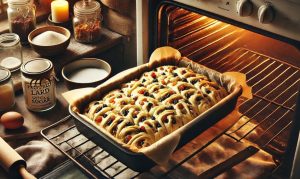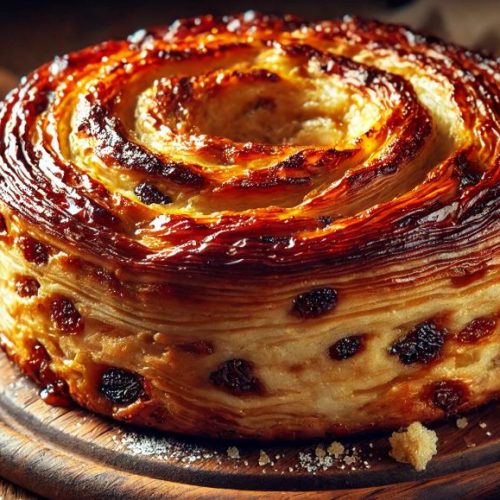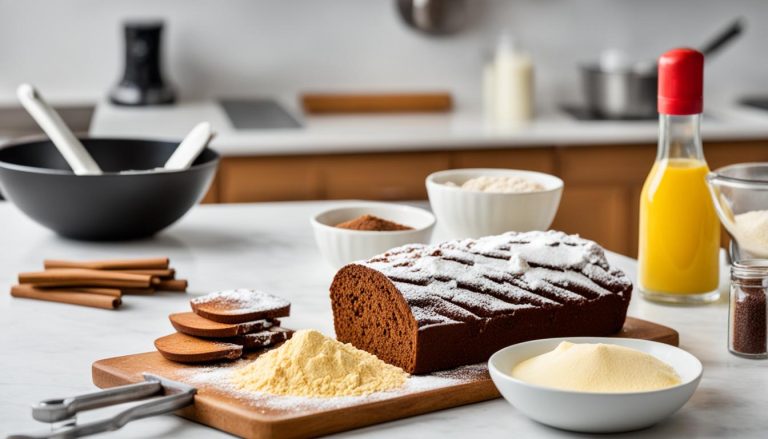Lardy Cake is a cherished British classic known for its rich, flaky layers of sweet dough interspersed with lard, dried fruits, and sugar. Originating in Wiltshire, this pastry has been a staple at village bakeries and family gatherings for centuries.
Its unique texture and sticky, caramelised crust make it a delightful treat for breakfast or afternoon tea. Whether you’re a seasoned baker or new to British pastries, this guide will walk you through the perfect Lardy Cake recipe.
What Is Lardy Cake?
Lardy Cake is a traditional British pastry, deeply rooted in the southern counties of England, particularly Wiltshire.
This rich and indulgent cake is more like a sweet bread, made from layers of enriched dough interlaced with lard, sugar, and dried fruit. Unlike most cakes, Lardy Cake is yeast-based, giving it a soft, bread-like texture while remaining sticky and sweet.
The origins of Lardy Cake date back to the 15th century when lard was more commonly used than butter due to its affordability.
Bakers would mix lard with flour, sugar, and spices, creating a unique texture and flavour that set it apart from other pastries. It was often baked for special occasions and celebrations, making it a symbol of comfort and festivity in many British households.
Over the years, variations of Lardy Cake have emerged, with some bakers adding nuts, mixed peel, or even a hint of cinnamon to the dough.
Despite its humble ingredients, the cake’s rich, flaky layers make it an indulgent treat that has stood the test of time. Today, it remains a beloved classic, often enjoyed with a cup of tea or served as a breakfast delight.
What Ingredients Are Needed for a Traditional Lardy Cake?
| Ingredient | Specification |
| Strong White Flour | 500g, for structure and texture |
| Lard | 100g, unsalted and good quality |
| Caster Sugar | 75g, fine for better incorporation |
| Dried Fruits | 100g (currants, raisins, or mixed peel) |
| Warm Water | 300ml, for activating yeast |
| Active Dry Yeast | 7g, to help the dough rise |
| Salt | 1 tsp, to balance flavours |
| Ground Cinnamon | 1 tsp, optional for added warmth |
| Nutmeg | A pinch, for a hint of spice |
Key Points
- Lard is crucial for its unique flaky layers; substituting it with butter will change the texture.
- Strong white flour is recommended to achieve the right consistency in the dough.
- Warm water helps activate the yeast, while sugar aids in fermentation.
- The addition of spices like cinnamon and nutmeg is optional but traditional in some regions.
How to Make Lardy Cake Step by Step?
Step 1: Prepare the Dough

- Combine the strong white flour and salt in a large mixing bowl.
- In a separate container, dissolve the yeast in warm water, then add it to the flour mixture.
- Mix until it forms a smooth dough, then knead for about 10 minutes until elastic and smooth.
Step 2: First Rise

- Place the dough in a lightly oiled bowl, cover it with a damp cloth, and let it rise for about 1 hour or until doubled in size.
Step 3: Layering the Lard and Sugar

- Roll out the dough on a floured surface to a large rectangle.
- Dot one-third of the lard across the surface, sprinkle with one-third of the sugar, and add a handful of dried fruits.
- Fold the dough into thirds, rotate it, and repeat the process twice more, ensuring the layers are well distributed.
Step 4: Final Rise and Bake

- Allow the dough to rest for another 30 minutes, then preheat your oven to 200°C (180°C fan, Gas Mark 6).
- Place the prepared dough in a lined baking tin and bake for 30–35 minutes or until golden brown and bubbling.
Can You Bake Lardy Cake Ahead of Time?
Lardy Cake is not only a delightful treat fresh from the oven but also a pastry that stores remarkably well. If you want to prepare it in advance for a gathering or simply to enjoy throughout the week, you can absolutely do so. Proper storage techniques ensure it maintains its soft, sticky texture and rich flavour.
- Once baked, allow it to cool completely before wrapping it tightly in foil or placing it in an airtight container.
- It can be kept at room temperature for up to 3 days, retaining its softness and flavour.
- For longer storage, freeze the Lardy Cake. Wrap it in foil and place it in a freezer-safe bag.
- When ready to enjoy, simply reheat in the oven at 160°C (320°F) for about 10 minutes to bring back its freshness and stickiness.
- Avoid microwaving as it can dry out the layers and alter the texture.
How Should You Serve and Store Lardy Cake?
Serving Lardy Cake warm is the traditional and most satisfying way to enjoy its rich, flaky layers and gooey sweetness. Proper storage helps maintain its quality, ensuring each bite is as good as the first.
- Best served warm, ideally straight from the oven or gently reheated for optimal stickiness.
- Perfectly pairs with a cup of English Breakfast Tea or Earl Grey for a classic British experience.
- Suitable as a breakfast pastry, mid-morning snack, or even a dessert.
- To store, keep it in an airtight container at room temperature for up to 3 days.
- If you want to extend its shelf life, freeze it for up to 1 month. Be sure to thaw it completely before reheating.
- For the best texture after freezing, warm it in the oven rather than the microwave.
What Are the Common Mistakes to Avoid When Baking Lardy Cake?

Although Lardy Cake is a relatively simple bake, there are a few common mistakes that can affect its texture and flavour. Avoid these pitfalls to achieve the perfect sticky, flaky layers that define this classic British pastry.
- Skipping the folds: This pastry relies heavily on layers of lard and sugar. If you skip or rush the folding process, the cake will lose its signature flakiness.
- Using cold water: Yeast needs warmth to activate properly. Always use warm water (around 38°C or 100°F) to get the right rise.
- Overbaking: Lardy Cake should be golden brown and sticky, not dry. Watch it closely during the last 10 minutes of baking.
- Substituting lard with butter: Lard is what gives this cake its distinctive texture. Although butter can be used, it won’t achieve the same flakiness.
- Not proofing enough: Make sure the dough is fully risen before baking, or the texture will be dense.
Is There a Healthier Version of Lardy Cake?
Lardy Cake is known for its indulgent layers of lard and sugar, but there are ways to make it a bit lighter while still preserving its delicious flavour. If you want to enjoy this treat with a little less guilt, try these healthier adjustments.
- Swap some of the lard for unsweetened applesauce—this reduces fat content while keeping it moist.
- Use whole wheat flour instead of white flour to add more fibre and nutrients.
- Reduce the sugar slightly and compensate with extra dried fruit for natural sweetness.
- Add nuts and seeds for extra crunch and protein.
- Consider baking at a slightly lower temperature for a longer time to maintain moisture with reduced fat.
Nutritional Information (Per Slice)
| Nutrient | Amount |
| Calories | 350 |
| Carbohydrates | 48g |
| Protein | 5g |
| Fat | 14g |
| Saturated Fat | 6g |
| Sugar | 18g |
| Fibre | 2g |
| Sodium | 150mg |
Serving Suggestions
Lardy Cake is best enjoyed warm, but there are several ways to elevate its flavour with complementary pairings. Here are some delightful ways to serve it for maximum enjoyment.
- Serve with a cup of English Breakfast tea or Earl Grey for an authentic British experience.
- Perfect as a breakfast pastry alongside fresh fruit or yogurt.
- Makes a delicious mid-morning snack to go with your coffee or hot chocolate.
- For a touch of luxury, enjoy with a dollop of clotted cream—a truly indulgent treat.
- You can also slice it and toast it lightly, adding a bit of butter for extra richness.
Conclusion
Lardy Cake is more than just a pastry, it’s a slice of British tradition with every bite. Its rich layers, sugary filling, and crispy top make it a truly unforgettable treat. Whether you follow the classic recipe or explore modern variations, Lardy Cake promises comfort and indulgence.
Try it warm with a cup of tea for the full experience, and discover why this classic continues to be a beloved favourite across the UK.
Frequently Asked Questions About Lardy Cake
What makes Lardy Cake different from other pastries?
Lardy Cake is distinct because of its use of lard instead of butter, creating exceptionally flaky layers. Its yeast-based dough also gives it a bread-like texture, unlike most cakes.
Can I substitute lard with butter in Lardy Cake?
Yes, you can substitute lard with butter, but it will change the texture. Lard provides a unique flakiness and richness that butter doesn’t fully replicate.
How long does Lardy Cake stay fresh?
When stored in an airtight container at room temperature, Lardy Cake stays fresh for up to 3 days. For longer storage, it can be frozen for up to 1 month.
Do I need to use bread flour, or can I use plain flour?
Bread flour is recommended for its higher gluten content, which gives Lardy Cake its characteristic structure and chewiness. Plain flour can be used, but the texture may be slightly softer.
Can I make Lardy Cake without dried fruit?
Yes, you can omit the dried fruit, but it is traditional to include it for added sweetness and texture. Some variations even add nuts or candied peel for extra flavour.
What is the best way to reheat Lardy Cake?
To reheat Lardy Cake, place it in a preheated oven at 160°C (320°F) for about 10 minutes. This helps restore its softness and sticky layers. Avoid using a microwave as it can make the texture rubbery.
Is Lardy Cake suitable for vegetarians?
Traditional Lardy Cake is not suitable for vegetarians due to the use of lard. However, you can substitute the lard with a vegetarian shortening if needed.

Lardy Cake Recipe
Ingredients
- 500 g Strong White Flour for structure and texture
- 100 g Lard unsalted and good quality
- 75 g Caster Sugar fine for better incorporation
- 100 g Dried Fruits currants, raisins, or mixed peel
- 300 ml Warm Water for activating yeast
- 7 g Active Dry Yeast to help the dough rise
- 1 tsp Salt to balance flavours
- 1 tsp Ground Cinnamon optional for added warmth
- Nutmeg for a hint of spice
Instructions
- Combine the strong white flour and salt in a large mixing bowl.500 g Strong White Flour
- In a separate container, dissolve the yeast in warm water, then add it to the flour mixture.100 g Lard
- Mix until it forms a smooth dough, then knead for about 10 minutes until elastic and smooth.300 ml Warm Water
- Place the dough in a lightly oiled bowl, cover it with a damp cloth, and let it rise for about 1 hour or until doubled in size.
- Roll out the dough on a floured surface to a large rectangle.
- Dot one-third of the lard across the surface, sprinkle with one-third of the sugar, and add a handful of dried fruits.75 g Caster Sugar, 100 g Dried Fruits, 7 g Active Dry Yeast
- Fold the dough into thirds, rotate it, and repeat the process twice more, ensuring the layers are well distributed.
- Allow the dough to rest for another 30 minutes, then preheat your oven to 200°C (180°C fan, Gas Mark 6).1 tsp Salt, 1 tsp Ground Cinnamon, Nutmeg
- Place the prepared dough in a lined baking tin and bake for 30–35 minutes or until golden brown and bubbling.









